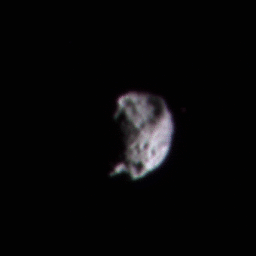Phoebe Rotation Movie
Caption:
Phoebe rotates through nearly one full rotation in this animated sequence of nine frames, taken on Cassini's approach to the small moon on June 10, 2004. Phoebe rotates on its axis once every 9 hours and 16 minutes; this sequence spans 8 hours and 14 minutes; all 360 degrees of longitude on Phoebe are visible in this sequence.
The surface is clearly covered by impact craters of a wide range of sizes, up to 40 percent of the diameter of the moon, creating rugged topography, illustrated dramatically along the terminator and limb.
The images that make up this sequence were obtained at a phase, or Sun-Phoebe-spacecraft, angle of 87 degrees, and from distances ranging from 877,453 kilometers (545,341 miles) to 688,924,000 kilometers (428,169 miles). The image scale ranges from 5.3 to 4.1 kilometers (3.3 to 2.6 miles) per pixel. To aid visibility, the images were magnified three times via linear interpolation; no contrast enhancement was performed.
Background Info:
The Cassini-Huygens mission is a cooperative project of NASA, the European Space Agency and the Italian Space Agency. The Jet Propulsion Laboratory, a division of the California Institute of Technology in Pasadena, manages the Cassini-Huygens mission for NASA's Office of Space Science, Washington, D.C. The Cassini orbiter and its two onboard cameras were designed, developed and assembled at JPL. The imaging team is based at the Space Science Institute, Boulder, Colo.
For more information about the Cassini-Huygens mission visit,
http://saturn.jpl.nasa.gov
and the Cassini imaging team home page,
http://ciclops.org
.
Cataloging Keywords:
| Name |
Value |
Additional Values |
| Target |
Phoebe |
|
| System |
Saturn |
|
| Target Type |
Satellite |
|
| Mission |
Cassini-Huygens |
|
| Instrument Host |
Cassini Orbiter |
|
| Host Type |
Orbiter |
|
| Instrument |
Imaging Science Subsystem (ISS) |
|
| Detector |
|
|
| Extra Keywords |
Crater, Grayscale, Impact, Movie, Rotation |
| Acquisition Date |
|
| Release Date |
2004-06-12 |
| Date in Caption |
2004-06-10 |
|
| Image Credit |
NASA/JPL/Space Science Institute |
| Source |
photojournal.jpl.nasa.gov/catalog/PIA06065 |
| Identifier |
PIA06065 |

 Planetary Data System
Planetary Data System
